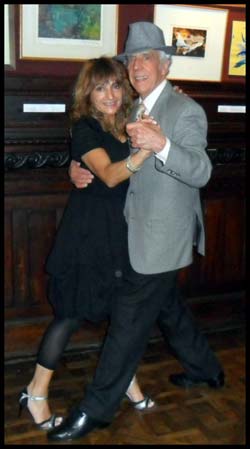By
A chat with the teacher and dancer, Ricardo Dupláa

e were virtually acquainted through an exchange of e-mails. I thought I had met Ricardo Dupláa personally through a friend in his neighborhood, but in fact it had not been him but his brother Julio, also dancer.
 After the confusion was cleared up, I asked him if he would talk about his career, and so this virtual interview came to be.
After the confusion was cleared up, I asked him if he would talk about his career, and so this virtual interview came to be.
He told me that he was born in the suburbs of Villa Urquiza, in the capital. «As I told you before, in an area called La Siberia because we were on the border of the province of Buenos Aires. My parents used to rent a house. Consequently, they were always looking for the cheapest place. So it was first on Mendoza Street, later, Acha, Pasaje Medeiros, and lastly 6257 Manuela Pedraza Street, a street that was parallel to the back of the Club Sin Rumbo, always in Villa Urquiza where we lived more than 20 years.
«I started the practice of tango dancing at age sixteen, in 1947, along with Gerardo Portalea and others that later were great dancers in that club, in a backyard in the open air. At that time you were not admitted to dance halls if you were a minor, but in the neighborhood clubs of my area they allowed us to enter many times.
«At age eighteen, document in hand, I was already dancing seriously. After many years of acquiring experience, in 1970, I devoted myself to teaching in people’s homes, at gatherings, libraries, institutions, not only dancing but also explaining and giving chats about tango.
«But in 1992 I began professionally, and was based in La Manzana de Las Luces where we have a tango workshop on Mondays and Thursdays from 6 pm to 8 pm.
«Furthermore, I gave classes at the Fundación IPNA (1998) —hired for six months—, with an average of attendants between 60 to 70 students; in the Canadian Embassy (1991-2001), when the ambassador was Mrs. Susan Harper; in the World Bank when the president was Mrs. Merna Alexander (1999-2002); at the Club Harrods-Gath & Chaves (2001); the International Monetary Fund (2001-2002); at the Dirección de Cultura de la Secretaría de Cultura del Gobierno de la Ciudad, with secretary Sara González (2000), where I organized and was president of the board in the first contest of neighborhood dancing in clubs of the Federal Capital, Virulazo Prize 2000, the project was called: Pa’ que bailen los muchachos.
«In 2007, I had a big surprise, the Consejo Argentino de la Danza, an entity member of the International Dance Council (CID) of Paris and the Secretaría Regional para América y el Caribe of UNESCO, gave me a Diploma de Honor at the Teatro Presidente Alvear for my ‘prolific work in teaching’, according to what the diploma says. It made me feel deeply honored because for twenty years’ time these diplomas have been awarded and for the first time it was awarded to a tango man, they were always for classical music or ballet.
«At eighty-something, full of life lessons, I keep on dancing and trying to help people learn to dance our music, without lifting their feet, sliding them on the floor with no leaps and no sprinting, listening to the music.
«In short, that is the way I feel it and how I convey it; I thank the courtesy of Todotango.com».
Of course, it is we who are grateful, to have the testimony of a legitimate porteño, a teacher of teachers.